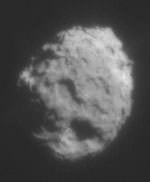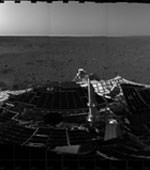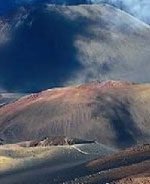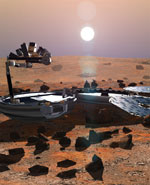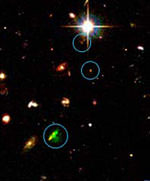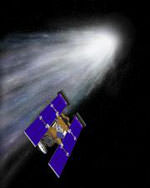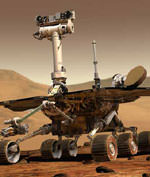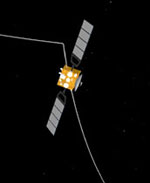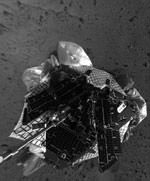
Image credit: NASA/JPL
With Spirit safely on the surface of Mars, engineers at NASA are starting to get a sense of the environment around it. So far, it looks like the rover couldn’t have landed in a better spot. The platform holding the rover is only tilted a few degrees, and there are no large rocks blocking the ramps. The terrain has lots of rocks to examine, but they’re well spaced out, which should let Spirit travel at a fairly high speed across the ground. Spirit will remain on the landing platform for another nine days or so before it ventures out onto search the area for evidence of past water.
NASA’s Spirit Rover is starting to examine its new surroundings, revealing a vast flatland well suited to the robot’s unprecedented mobility and scientific toolkit.
“Spirit has told us that it is healthy,” Jennifer Trosper of NASA’s Jet Propulsion Laboratory, Pasadena, Calif., said today. Trosper is Spirit mission manager for operations on Mars’ surface. The rover remains perched on its lander platform, and the next nine days or more will be spent preparing for egress, or rolling off, onto the martian surface.
With only two degrees of tilt, with the deck toward the front an average of only about 37 centimeters (15 inches) off the ground, and with apparently no large rocks blocking the way, the lander is in good position for egress. “The egress path we’re working toward is straight ahead,” Trosper said.
The rover’s initial images excited scientists about the prospects of exploring the region after the roll-off.
“My hat is off to the navigation team because they did a fantastic job of getting us right where we wanted to be,” said Dr. Steve Squyres of Cornell University, Ithaca, N.Y., principal investigator for the science payload. By correlating images taken by Spirit with earlier images from spacecraft orbiting Mars, the mission team has determined that the rover appears to be in a region marked with numerous swaths where dust devils have removed brighter dust and left darker gravel behind.
“This is our new neighborhood,” Squyres said. “We hit the sweet spot. We wanted someplace where the wind had cleared off the rocks for us. We’ve landed in a place that’s so thick with dust devil tracks that a lot of the dust has been blown away.”
The terrain looks different from any of the sites examined by NASA’s three previous successful landers — the two Vikings in 1976 and Mars Pathfinder in 1997.
“What we’re seeing is a section of surface that is remarkably devoid of big boulders, at least in our immediate vicinity, and that’s good news because big boulders are something we would have trouble driving over,” Squyres said. “We see a rock population that is different from anything we’ve seen elsewhere on Mars, and it comes out very much in our favor.”
Spirit arrived at Mars Jan. 3 (EST and PST; Jan. 4 Universal Time) after a seven month journey. Its task is to spend the next three months exploring for clues in rocks and soil about whether the past environment at this part of Mars was ever watery and suitable to sustain life.
Spirit’s twin Mars Exploration Rover, Opportunity, will reach its landing site on the opposite side of Mars on Jan. 25 (EST and Universal Time; Jan. 24 PST) to begin a similar examination of a site on the opposite side of the planet from Gusev Crater.
JPL, a division of the California Institute of Technology, manages the Mars Exploration Rover project for NASA’s Office of Space Science, Washington. Additional information about the project is available from JPL at: http://marsrovers.jpl.nasa.gov and from Cornell University at: http://athena.cornell.edu.
Original Source: NASA/JPL News Release

